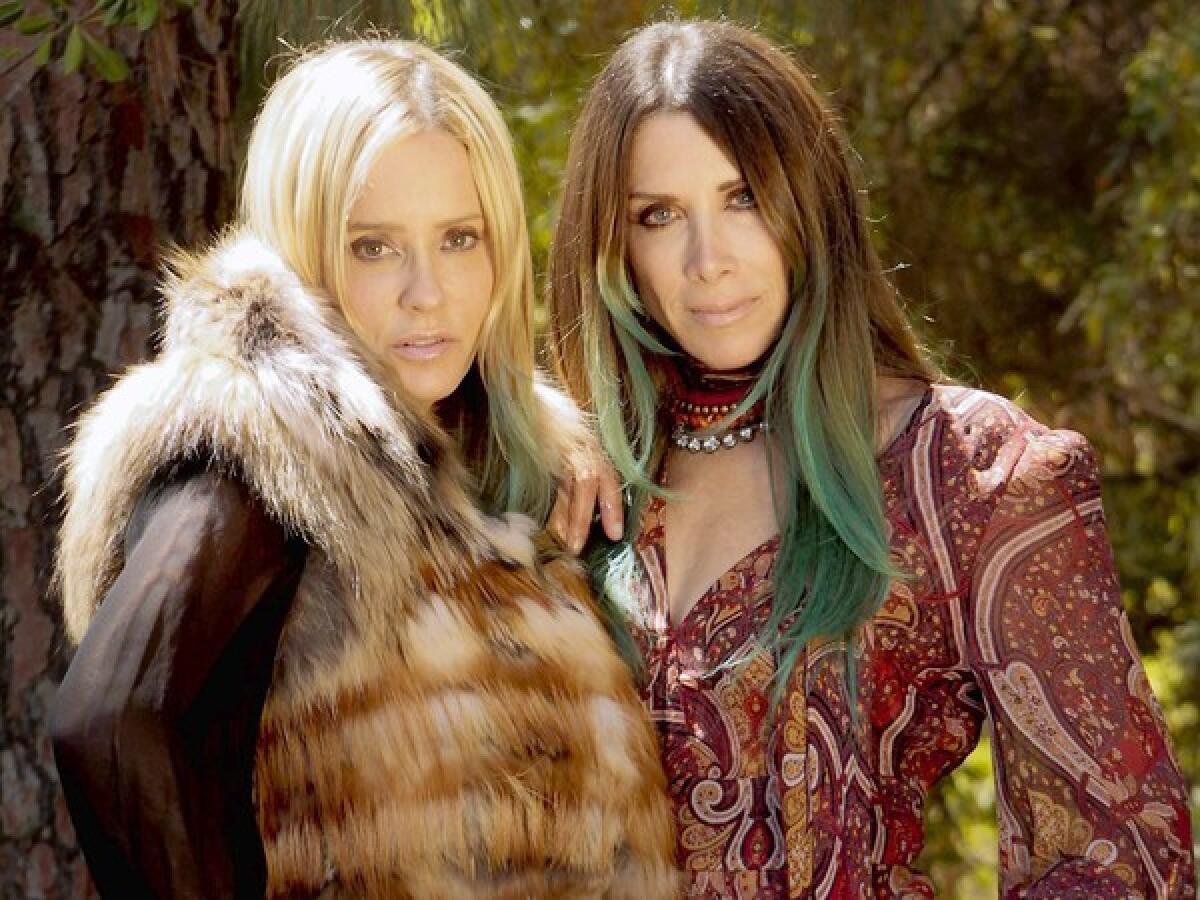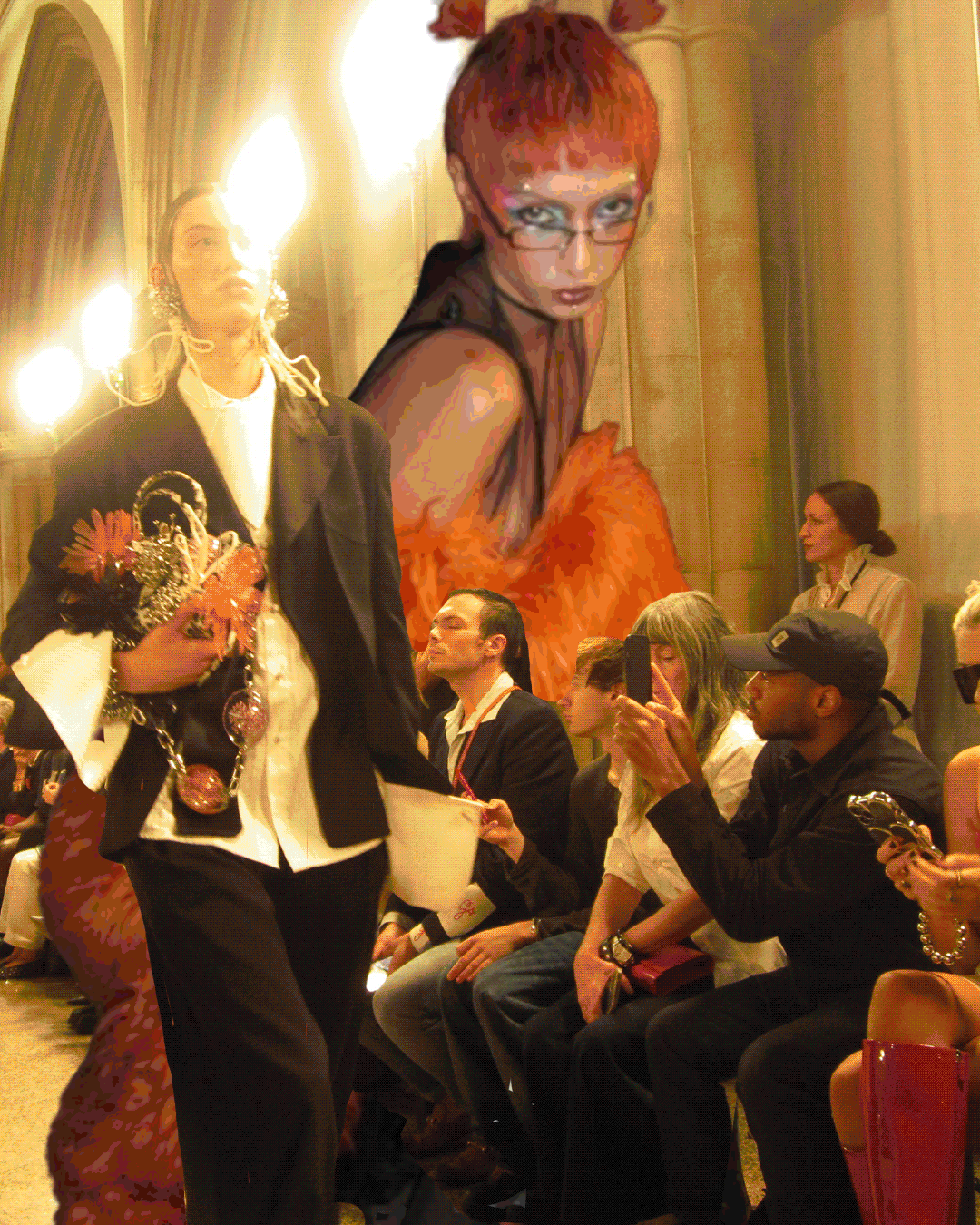From Juicy Couture to Skaist Taylor

With their matching paisley mini dresses, matching teal streaks in their hair and matching snakeskin booties, fashion designers Pamela Skaist-Levy and Gela Nash-Taylor are a head-turning vision as they breeze into Soho House, two peas in a haute-hippie pod.
Their silhouette is all fierce bohemia — Marrakech romance teamed with Studio 54 party vibes, with remnants of 1960s and ‘70s fashionistas Talitha Getty, Jerry Hall and Marianne Faithfull stitched into a casually glamorous daytime uniform.
“We call our look ‘California Eccentric,’” says Skaist-Levy, ordering a pair of matching kale salads for Nash-Taylor and herself. It’s a look that carries into their new women’s clothing line, Skaist Taylor, debuting in stores in August and something of a departure from their past design endeavors.
FOR THE RECORD:
Skaist Taylor: Elsewhere in this edition, an Image section article about the fashion label Skaist Taylor said designer Gela Nash-Taylor is married to Duran Duran’s Nick Taylor. His first name is John. The error was detected after the section went to press. —
Best friends for 23 years, the two have been business partners since 1996, when they founded Juicy Couture out of Nash-Taylor’s one-bedroom apartment, giving birth to the velour tracksuit craze of the noughties. Between them, the women transformed the humble track pant from casual closet staple into premium must-have, “non-fashion at its most fashionable ... it may be the future of the way we dress,” declared Vogue in 2003.
Tracksuits were priced around $200, the pants coming complete with cute “Viva La Juicy” or “Juicy Bling” mantras, sometimes written saucily across the buttocks.
The apogee of comfort-based utilitarianism, the Juicy tracksuit seems diametrically opposite to the free-spirited, eclectic gypsetter look they’re championing today in their new line. Times have changed.
Juicy came into being in the era of Hollywood comfort-bling, when denim was embellished and embroidered, and T-shirt logos were gothic and silvery. New York winced as Los Angeles exploded with these cheerful homages to conspicuous consumption. By the mid-2000s, you couldn’t open Us Weekly without seeing Paris Hilton, Lindsay Lohan or Nicole Richie in top-to-toe Juicy, clutching a Starbucks cup or a small dog, or both.
The runaway success of the tracksuits came as somewhat of a surprise to Skaist-Levy and Nash-Taylor, who were never quite as obsessed with their creation as the rest of America seemed to be.
“We loved the track pants, but we didn’t really wear the head-to-toe tracksuits,” Nash-Taylor confesses. “But those things had a life of their own. We were, like, ‘OK ... I guess we better hold on and go for the ride.’” (It’s true that if you go to Google Image and search for Skaist-Levy and Nash-Taylor during the Juicy era, you won’t find many photos of them wearing the tracksuits — rather, the top hats, feathers, silk, dyed fox furs and lace foreshadow their current line.)
Skaist-Levy and Nash-Taylor loved the pretty mini caftans and other boho looks they also designed for Juicy, as did their celebrity fans. But it was the tracksuit that became iconic, dominating the brand’s identity, proliferating in malls and on college campuses across the United States.
In 2003, with Juicy in more than 1,000 stores around the world and annual sales of nearly $50 million, Skaist-Levy and Nash-Taylor sold the company toLiz Claiborne Inc.(now Fifth & Pacific Cos.), netting more than $200 million, they say. The BFFs had officially hit the big time.
They hated it. Not the money, but being part of a huge company — Fifth & Pacific also owns Kate Spade, Jack Spade and Lucky Brand Jeans. And they hated losing creative control of the brand.
They stuck around for seven years before parting ways with Fifth & Pacific. “We stayed at that party waaaay too long,” Skaist-Levy, 49, says. “We should have grabbed our coat and our shoes and gone home.”
Nash-Taylor, 53, adds, “Juicy, even though it was the most amazing ride ever, it stopped being fun. And that was hard.”
They left Juicy Couture in 2010 and would have jumped straight into a new project were it not for the non-compete clause of their contract, which barred them from starting any new businesses for 17 months. This enforced sabbatical turned out to be the best thing that could have happened, they say, a sort of”Eat Pray Love”moment during which they were able to reconnect with their inner designers and manifest the new line.
Nash-Taylor hung out in London with her husband, John Taylor of the band Duran Duran, soaking up the scene at flea markets and vintage shows.
FOR THE RECORD
Skaist Taylor: A July 22 article about the fashion label Skaist Taylor said designer Gela Nash-Taylor is married to Duran Duran’s Nick Taylor. His first name is John.
“There’s a lot of noise in the world of fashion,” Nash-Taylor says. “You’re bombarded with images and politics and marketing … but that time allowed me to think about the things I really wanted to wear and make. It took me back to basics, to all the things that I believed in and liked.”
Skaist-Levy, whose husband, Jeff Levy, is a rock musician and film producer, did the same, browsing around Etsy and EBay, perusing vintage wares and adding to the mental vision board that would provide the foundation for Skaist Taylor. “It was a great experience being on that non-compete,” she says. It provided “17 months to go back and think, ‘What do I want to make now?’ Without the confines of what it had to be. It was perfect.”
One day, while the two women were apart, they each happened to watch a film featuring Italian actress and rock ‘n’ roll muse Anita Pallenberg. Re-inspired by Pallenberg’s style, Skaist-Levy called her best friend and said, “I’m really feeling Anita ...,” with Nash-Taylor finishing her sentence: “Pallenberg? Me too!” They took the coincidence as a sign that Pallenberg and her free-spirited ilk should be their totems, reminders of what it was they always loved about fashion in the first place.
And that meant “individual, free-spirited and eclectic,” Nash-Taylor says. “As far as the company, small and fun is what we wanted this time around, and non-corporate for as long as we can.”
Skaist Taylor presented its first collection in February, in a cold parking lot beneath Lincoln Center during New York Fashion Week. Vogue editor in chief Anna Wintour and other fashion luminaries gathered in the underground space, where dreamy shots of California redwoods were projected on the walls. Models channeled Jane Birkin and Barbarella as they glided not on a catwalk but through the crowd, dressed in oversize fur coats, metallic mini dresses, embroidered blouses with full poet sleeves, sheer backless black dresses that nodded to Emanuel Ungaro and skintight leather pants. “It’s so fresh, so L.A.,” were the murmurs.
There was a small nod to the designers’ past in the shape of a Japanese velour tracksuit, because “casual luxury doesn’t just go away,” Skaist-Levy says. But other than that, the look was defiantly boho, with only a glimmer of bling.
Hamish Bowles, international editor at large for Vogue, noted the difference, saying via email on Thursday: “The Juicy girl is the Skaist Taylor woman at her most laid back and off-duty, but I think that what Pam and Gela are doing with their new label is very different — it’s more sophisticated, more fashion forward and more niche.”
Among the models was Theodora Richards — daughter of Rolling Stones guitar legend Keith Richards and model Patti Hansen — a “crazy little angel” who served as muse for the collection. “When we thought about the collection, we were, like, ‘Who really would be the perfect girl in spirit and vibe?’” Skaist-Levy says, “and it was Theo. She was inspiring, amazing and we loved her. When she saw the python-skin boots she was, like, ‘I’m in.’”
So were the buyers — Neiman Marcus, Net-A-Porter, Maxfield, Bergdorf Goodman and Nordstrom all scooped up the collection for this fall, as did Harvey Nichols and Harrods in London, among other retailers.
“It’s a triumph,” says Ken Downing, fashion director of Neiman Marcus. “Expressing your personal spirit is where fashion is going, and they have their finger on the pulse of that.” The collection was less designed for design’s sake, he says, and more like “an incredible wardrobe” that someone might have collected over time.
“It didn’t have one single note, it sang in many different tones,” Downing says. “And there was an edge to it; really feminine but at times it took on masculine qualities, coming together in a harmonious way. Great tension is always the sign of a great collection.” Retailers are expected to price the collection between $600 and $1,000 for dresses, $295 to $500 for knitwear, $400 to $500 for trousers and $1,000 to $2,000 for outerwear.
Will the woman who wore Juicy Couture in 2002 want to wear Skaist Taylor in 2012? Downing hopes so. “That woman, like all of us, is in a different place now,” he says. “It’s a new fashion moment.”
Although the looks have a definite California feel, Bowles says, “Pam and Gela are both global citizens, and they mix couture with vintage and cutting-edge contemporary in an exciting way in their own wardrobes and that’s reflected in their runway. I think it’s a seductive look for customers around the world.”
One thing is for sure: Skaist Taylor represents a new kind of Californian eccentricity for its creators. “We’re keeping things authentic and we’re keeping things us,” Skaist-Levy says. “All the way.”






